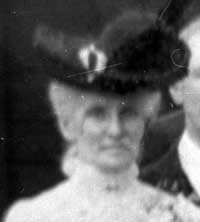
My great grandmother, Elizabeth (Lizzie) Smith (neé Gadsby – or sometimes, Gadsbey) was born in Stone 1n 1861. She was the second daughter of James and Martha Gadsby.

Martha was also a first cousin of my maternal grandfather, Arthur Downing.
To put this another way, my mother’s parents were first cousins once removed.
Although Lizzie was alive until I was about six years old, I have few strong memories of her. She had a reputation within the family for being rather outspoken and forbidding, but this might have only been in her later years She lived to be 87.
I do remember a regular custom when we visited Victor Street though. This was usually on a Sunday afternoon, having driven north from Birmingham via Stafford – with the fascination of its milk bottling plant – with large plate glass windows making the machinery visible from the road as my brother and I sat perched on cushions in the back of Winchurch Brothers’ green livery painted Austin A40 van.
After we had parked outside in the narrow road which was arrow straight between the leaded steps of the terraced houses, we passed down the arched ‘entry’ to the yard and turned left for the back door to number 7.
One of Lizzie’s first questions was invariably to ask if we boys would like a biscuit and this affirmed she would pull open a drawer in a huge red wooden chest of drawers, which dominated one side of the small living room and take out a packet of Lincoln Cream biscuits.
They were always Lincoln Creams and I loved them !
At this time food, and especially ‘luxury food’ was severely rationed in post war Britain, so this gesture was particularly generous
I think Lizzie and Arthur lived in their small, rented, terraced house for all of their married life. My mother, Margaret Downing was born there in 1916 and I think her mother, Annie Elizabeth Smith was born there in 1883. ( I have sent for a copy of Annie’s birth certificte to confirm this). The family, with the exception of Annie, was certainly there at the time of the 1901 census.
A large portrait of ‘Mr Gladstone’ dominated the chimney breast in the living room. This was, I believe, a reflection of Lizzie’s political leanings rather than Arthur’s, who I suspect, from family comments, was a little frightened of her !
The house had no electricity even in the late 1940s. There was no bathroom and the only water tap was a cold one over the brown porcelain kitchen sink. This supply had replaced water drawn from a well sited in the pantry under the stairs, which I believe had served not only number 7 but several other houses in Victor Street until the 1920s. Lighting, as in many Victorian terraced houses was by town gas.
Add to all of the above hardships two of the bloodiest wars in history, poverty and illness.
Lizzie’s life was certainly not an easy one and it is a tribute to her determination and that of so many like her that she survived as a formidable figure, into her late eighties, surrounded by children, grandchildren and great granchildren.